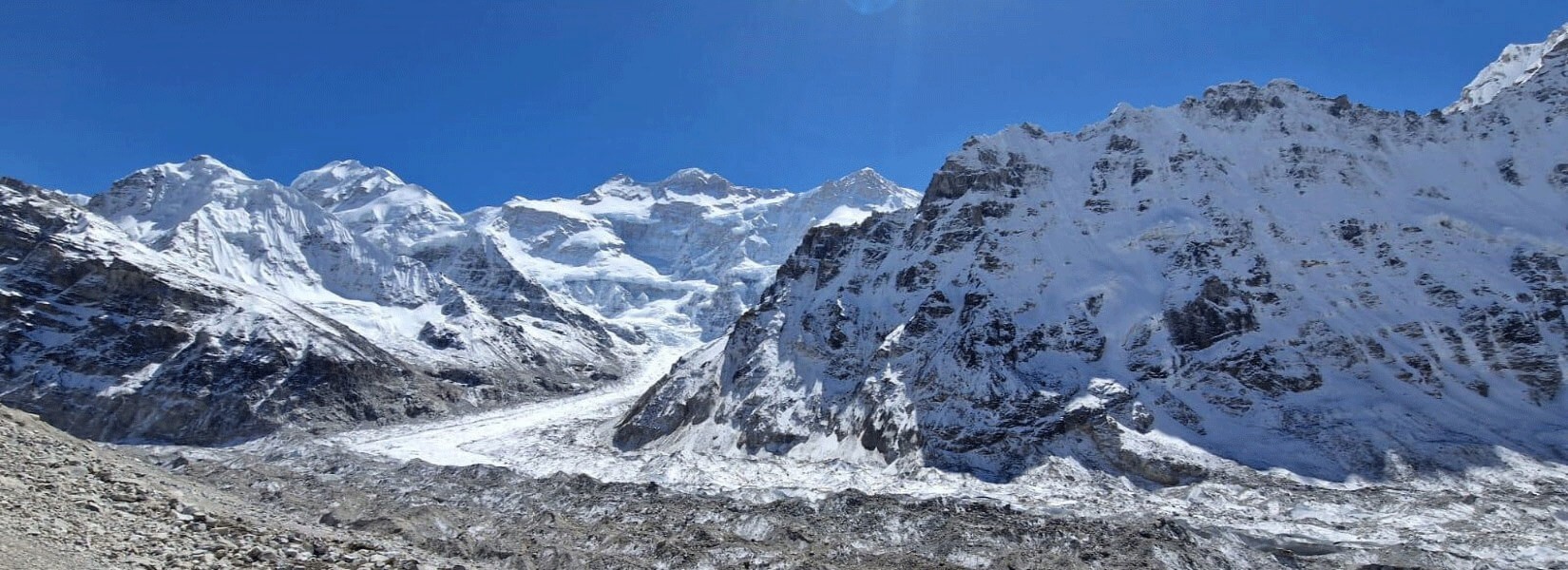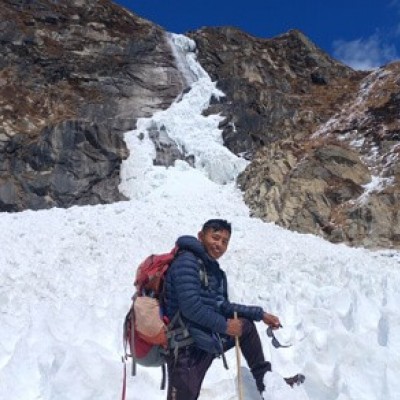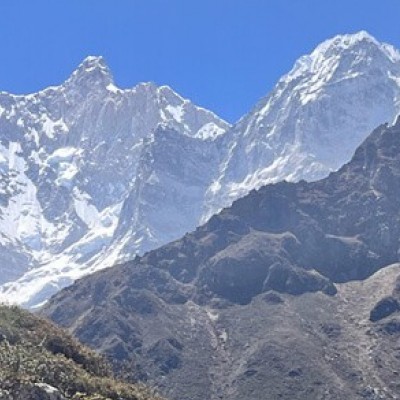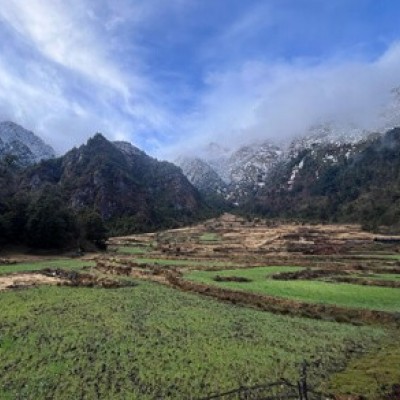What is the total distance of the Kanchenjunga Trekking ?
The Kanchenjunga trek distance varies based on different factors, such as the route you choose and the transportation services you use to reach the initial point of the trek. If you select the Kanchenjunga Circuit trek, including both Kanchenjunga North/Pangpema Base Camp and South/Oktang Base Camp, the journey covers about 200 kilometers to 220 kilometers (124 miles to 137 miles). For this exciting journey, you can select a private or public bus to reach Taplejung, the beginning point of the Kanchenjunga Circuit trek from Kathmandu, first drive to Illam (655 km), and then proceed to Taplejung (150 to 152 km) with another enjoyable road ride.
Like this, the classic Kanchenjunga Circuit trek makes it one of Nepal's most extensive and remote trekking routes through lush woodlands, rough landmarks, and high mountain passes like Sele La and Mirgin La. As an option, if you choose to reach either Oktang (4730m) or Pangpema (5143m), the total Kanchenjunga trekking days and distance become shorter, with around 100 to 130 kilometers.
For those who want to reach both base camps but less lengthily than classic routes, Nepal Adventure Team also has a package of “ Short Kanchenjunga Base Camp Trek,” which covers 155 to 162 kilometers, beginning from Sekathum and ending at Ranipul. During this journey, you use a flight to reach Bhadrapur and a private jeep to reach the initial point of the Kanchenjunga Trek.
How many days does it take to complete the trek?
The Kanchenjunga trek duration might be longer than other commercial and popular trekking trails, such as the Annapurna region trek and the Everest region trek, due to its remoteness and high terrain with steep ascents and descents. Generally, Kanchenjunga trekking concludes within 15 to 25 days based on the journey logistics, acclimatization, and the selected routes. We have various packages for the Kanchenjunga region, which last for 15 days to 26 days.
You may complete the trek within 15 to 17 days when you take only the north or south base camp route, beginning from Sekathum or Khebang after flying to Bhadrapur and driving to the initial points. The total Kanchenjunga trekking days may extend when trekkers need more time to adapt to the environment of the Kanchenjunga region. However, if you prepare physically and mentally before embarking on the trek, you will be able to complete it within a common duration, as other trekkers do.
Which routes are available for Kanchenjunga trekking, and what is their trail length?
The Kanchenjunga region offers you several trekking routes, although the trails are not well-marked and less traveled. Each trekking trail provides you with a unique experience, with both rewards of natural gems and challenges. The major available routes are as follows:
Classic Kanchenjunga Circuit Trek
Day 01: Arrival in Kathmandu and transfer to the hotel to unwind
Day 02: Guided Kathmandu sightseeing and trek preparation (4-5 hours)
Day 03: Drive to Ilam by deluxe AC bus (15-16 hours) / 655 km
Day 04: Drive to Taplejung (7-8 hours) (240km)
Day 05: Trek from Taplejung to Mitlung (5-6 hours) / 9 to 12km
Day 06: Mitlung to Chiruwa (5-6 hours) 16 km
Day 07: Trek from Cheruwa to Sekathum (5-6 hours) 16km
Day 08: Sekathum to Amjilosa (4-5 hours) / 12km
Day 09: Amjilosa to Gyabla (5-6 hours) / 10km
Day 10: Trek from Gyabla to Village of Ghunsa ( 5-6 hours) / 11 km
Day 11: Acclimatization day at Ghunsa (rest day)
Day 12: Trek from Ghunsa to Khambachen (6-7 hours) / 9.5 km
Day 13: Trek from Khambachen to Lhonak. (6-7 hours) / 10km
Day 14: Trek from Lhonak to Kanchenjunga North Base Camp and return to Lhonak (7-8 hours) / 20km
Day 15: Trek from Lhonak to Ghunsa. (7-8 hours) / 22km
Day 16: Ghunsa to Se Le High Camp. (5-6 hours) / 11km
Day 17: Trek from Sele Le High Camp to Cheram via Sele-La Pass. (7-8 hours) / 12 km
Day 18: Trek from Chairam to Ramche. (6-7 hours) / 7 km
Day 19: Ramche—Explore Yalung Base Camp and return to Chairam (7-8 hours) / 6-7 km
Day 20: Trek from Chairam to Torongding. (5 hours) 7 km
Day 21: Torongding to Yamphuding. (6-7 hours treks) / 20 km
Day 22: Yamphudin to Khebang (5-6 hours trek) / 14 km
Day 23: Drive from Khebang to Phikkal (6-7 hours)
Day 24: Drive to Bhadrapur Airport and fly back to Kathmandu / 58 km ( 1-2 hours of driving, 40-45 minutes of flying)
Day 25: Final Departure.
Kanchenjunga South Base Camp Trek
Day 01: Arrival in Kathmandu and transfer to the hotel
Day 02: Apply for special permits and fly to Bhadrapur, then a short drive to Phikkal (40-45 m and drive 3-4 hours.
Day 03: Drive to Khebang from Phikkal (6-7 hours) / 442 km
Day 04: Trek from Khebang to Yamphudin (5-6 hours) / 14 km
Day 05: Trek from Yamphudin to New Jhoreni (6 to 7 hours) / 8 km
Day 06: Trek from New Jhoreni to Torongding (7-8 hours) 20 to 22 km
Day 07: Trek from Toronding to Chairam (5 hours) / 11 km
Day 08: Trek from Chairam to Ramjer/Ramche (4-5 hours) / 7 km
Day 09: Explore South Base Camp and get back to Ramche (6-7 hours) / 6-7 km
Day 10: Trek from Ramche to Chairam to Torongding (6-7 hours) / 7 km
Day 11: Trek from Torongding to Rani Pul (7-8 hours) / 20 to 22 km
Day 12: Drive from Rani Pul to Taplejung (3 to 4 hours) / 70 km
Day 13: Drive back to Phikkal (4-5 hours), 240 km
Day 14: Drive to Bhadrapur and fly back to Kathmandu (4-5 hours) / 58 km
Day 15: Final departure
Kanchenjunga North Base Camp Trek
Day 01: Arrival in Kathmandu (1350 m)
Day 02: Submit the Kanchenjunga permit and fly to Bhadrapur (45-50 minutes) and drive to Phikkal (1.5 or 2 hours) / 58 km
Day 03: Drive from Phikkal to Taplejung (7-8 hours) / 240 km
Day 04: Drive from Taplejung to Sekathum (5 to 6 hours) / 70-75 km
Day 05: Trek from Sekathum to Amjilosa (4-6 hours) / 9 km
Day 06: Trek from Amjilosa to Gyabla (4-5 hours) / 5-6 km
Day 07: Trek from Gyabla to Ghunsa (5-6 hours) 11 km
Day 08: Rest Day in Ghunsa for Acclimatization
Day 09: Trek from Ghunsa to Khambachen (5-6 hours) / 9.5 km
Day 10: Trek from Khambachen to Lhonak (5-6 hours) / 10 km
Day 11: Lhonak to Pangpema base camp and return to Lhonak (7-8 hours) / 15 km
Day 12: Lhonak to Khambachen to Ghunsa (6-8 hours) / 9.5 km
Day 13: Trek from Ghunsa to Amjilosa (7-9 hours) / 11 km
Day 14: Amjilosa to Sekathum and drive to Taplejung for 5-6 hours (private Jeep) / trek distance(6.6km) and drive distance (40km)
Day 15: Drive from Taplejung to Phikkal (4-5 hours) / 240 km
Day 16: Drive to Bhadrapur and fly to Kathmandu (7-9 hours)
Day 17: Departure time
Comparison Between Classic Kanchenjunga Circuit Trek and Kanchenjunga Base Camp North /South) Trek
Classic Kanchenjunga Circuit Trek usually covers 200 to 220 km of hiking through diverse landscapes of the Kanchenjunga region, which takes approximately 21 to 26 days. If you choose either the Kanchenjunga North or South Base Camp trek, then it covers only 100 to 130 kilometers, spanning from 15 to 17 days. The comparison between the Kanchenjunga circuit and base camp, including Kanchenjunga Circuit Trek length and Base Camp length, is as follows:
| Feature | Kanchenjunga Circuit Trek | Kanchenjunga North (Pangpema) Base Camp Trek | Kanchenjunga South (Oktang) Base Camp Trek |
| Total Length | 200 to 220 km | 120 to 130 km | 110 to 120 km |
| Total Duration | 21 to 26 Days | 11 to 17 Days | 11 to 15 Days |
| Difficulty level | Challenging | Challenging | Challenging |
| Highest Elevation | 5143 m | 5143 m | 4730 m |
| Road Impact | Minimal | moderate | moderate |
| Best Time | Spring (Mar-May) and Autumn(Sep-Nov) | Spring (Mar-May) and Autumn(Sep-Nov) | Spring (Mar-May) and Autumn(Sep-Nov) |
What factors affect the trek duration and difficulty?
We have numerous factors that impact the Kanchenjunga trails. Some of them are as follows:
How can altitude make your trek longer?
Kanchenjunga trekking takes you to the mountainous terrain above 4000m, where the level of oxygen becomes very low, causing high-altitude-related problems. The symptoms, such as headache, dizziness, nausea, chest tightness, etc., appear in trekkers while hiking in a rush. Since sufficient acclimatization is crucial to overcome several obstacles on trails, the Kanchenjunga trek duration may be longer than on easier trails like the Langtang Valley trek or the Ghorepani Poon Hill trek.
Does the terrain of the Kanchenjunga region impact its duration?
As the Kanchenjunga trekking route is one of the most isolated trails in Nepal, it takes you to terrain with no access to transportation, internet, or other modern facilities. The trails are not well-marked, making it difficult for trekkers to navigate them due to factors including unpredictable weather and steep terrain. High mountain passes, technical descents, landslide-prone areas, and such challenging terrain of the region may impact the duration and difficulty of the journey. Although you prepare properly, the narrow, icy, and snowy trails leave you exhausted as the hiking requires extra strength.
How does the distance of the Kanchenjunga trek influence its duration?
Generally, Kanchenjunga trekking takes 15 to 26 days, requiring good physical condition and mental resilience. Trekkers may feel exhausted because of walking for 6 to 7 hours, covering 9 to 10 km on average per day. Although you can fly directly to Bhadrapur or Taplejung and then drive to the initial point of the Kanchenjunga trek, the overall duration remains roughly the same as previously mentioned. This is because Kanchenjunga trekking is one of the longest and most challenging hikes in Nepal, covering 100 to 220 km over 15 to 26 days of trekking. In this way, the total Kanchenjunga trail length impacts the duration and difficulty of the trek.
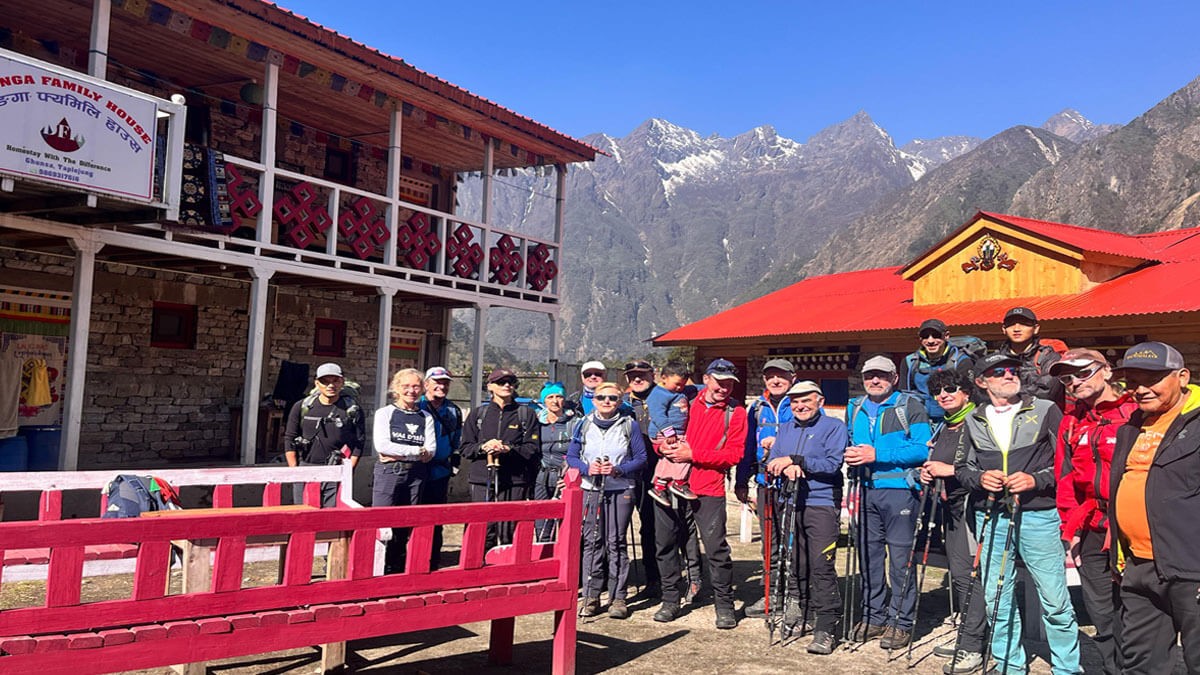
How does the weather impact the Kanchenjunga trek duration?
The journey begins in stunning valleys and takes you to the more rugged landscapes of the Kanchenjunga region above 5000m. In high-altitude terrain, the weather frequently changes in no time, bringing harsh conditions due to heavy snowfall and rainfall. The risk of trail blockage is high due to landslides and avalanches, forcing several trekkers to return or face more obstacles on the trails.
Such unforeseen conditions as harsh cold, snow, rain, or chilly wind impact a trekker’s walking pace, increasing challenges as well as leading to extended Kanchenjunga trekking days. Physical and mental challenges of the trek increase because of variations in altitude and weather, affecting the trail conditions. Therefore, it is crucial to ensure that your Nepal trekking guide has expertise in predicting any place’s weather to reduce such problems throughout the trek.
Do Physical Fitness and Preparation impact on Kanchenjunga trek duration?
Since the difficulty level of the Kanchenjunga trek is moderate to strenuous, we usually suggest that every individual engage in cardiovascular exercises before venturing into it. To make yourself strong enough for walking long kilometers, you have to prepare yourself 1 or 2 months before the trek. Additionally, you can strengthen your legs for the Kanchenjunga trek by doing various exercises such as walking, running, jumping, swimming, and hiking.
Hikers with no prior experience of the Himalayan odyssey might feel this trek is impossible since it requires a good physical level and mental practice with the proper trekking gear due to its long distance, high altitude, and demanding terrain, including high mountain passes like Sele La and Mirgin La. A trekker with prior experience also finds it difficult to navigate trails within a shorter duration when symptoms of Acute Mountain Sickness (AMS) occur. In such conditions, you need gradual ascents with a smooth pace and acclimatization days. Additionally, you should prepare properly and strategically pack your bag without missing essential things for the trek.
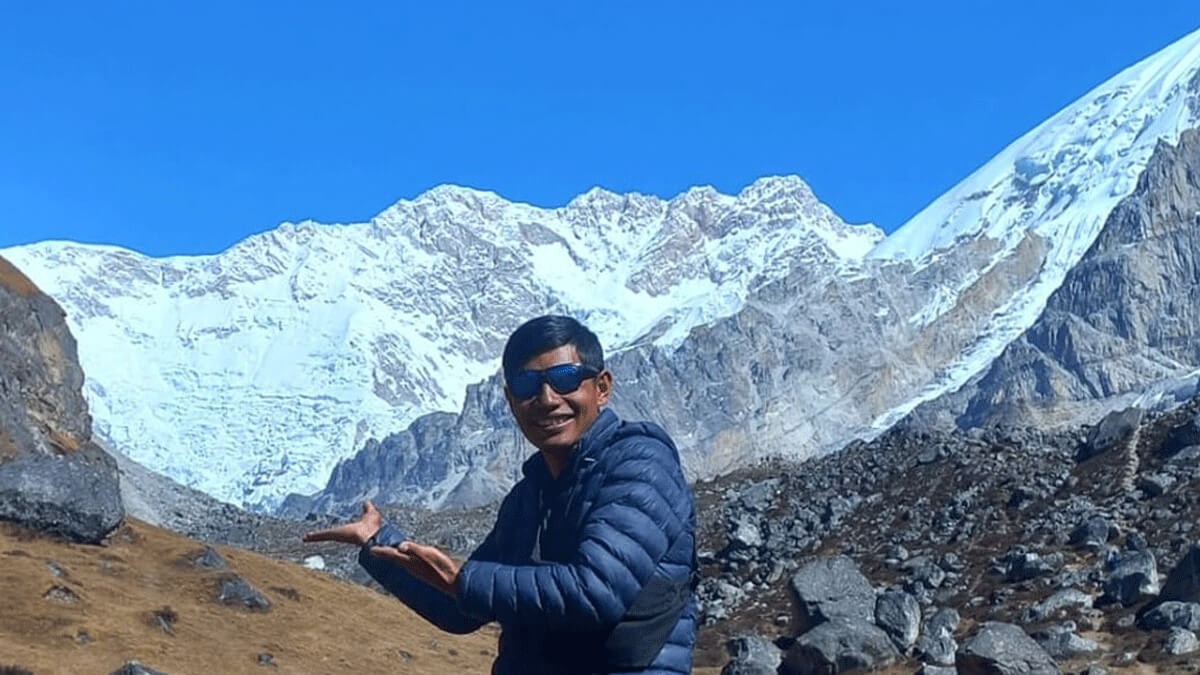
How does pack weight affect the Kanchenjunga trek duration?
Packing your backpack wisely is also a key to a successful journey in the heart of the Kanchenjunga. A porter is not mandatory as a trekking guide for Kanchenjunga hiking, resulting in heavy loads of trekking gear and other essentials, making trekkers fatigued, impacting speed, and thus the duration of the trek. While walking on steep terrains through remote areas, trekkers need to be cautious, making slower progress due to unnecessary packing lists. To enjoy it without worrying about your backpack, it is better to hire a local porter who allows you to walk freely, savoring the charm of natural grandeur.
Remoteness and Accessibility: How is it a factor that impacts the Kachenjunga hiking duration?
Limited accommodation and food items are available along the Kanchenjunga trekking trail due to the difficulty of accessibility of transportation and its isolated terrain. Although you will find facilitated lodges in lower elevations, you can not find emergency medical evacuation, internet services, and other modern amenities in high, isolated terrain.
These things impact adventurers’ mental health, forcing them to return without completing the journey, which increases planning challenges. In comparison to popular trekking destinations like Everest Base Camp or Annapurna Base Camp, the Kanchenjunga Base Camp trek is more demanding due to its difficult sections and limited services. If a hiker gets injured on the Kanchenjunga trek, it takes time for medical treatment due to the remote and rugged location.
Conclusion
To sum up, although the Kanchenjunga trekking is longer, taking you to the most isolated areas of far eastern Nepal, it offers a unique experience with surprises at every step of the trek. Therefore, if you are ready to lace your boots up to savor the beauty of such wilderness, we are here at Nepal Adventure Team to help you while planning your journey. Whether you choose the longest classic Kanchenjunga Circuit trek or the shortest Kanchenjunga trek that takes you to either Pangpema or Oktang Base Camp, your safety is our priority.
We provide a seasoned trekking guide and a local porter to make your odyssey more joyful. If you're looking for a more facilitated trekking experience, regions like Annapurna or Everest offer well-established trekking packages. Our trekking packages are customizable based on your preferences.
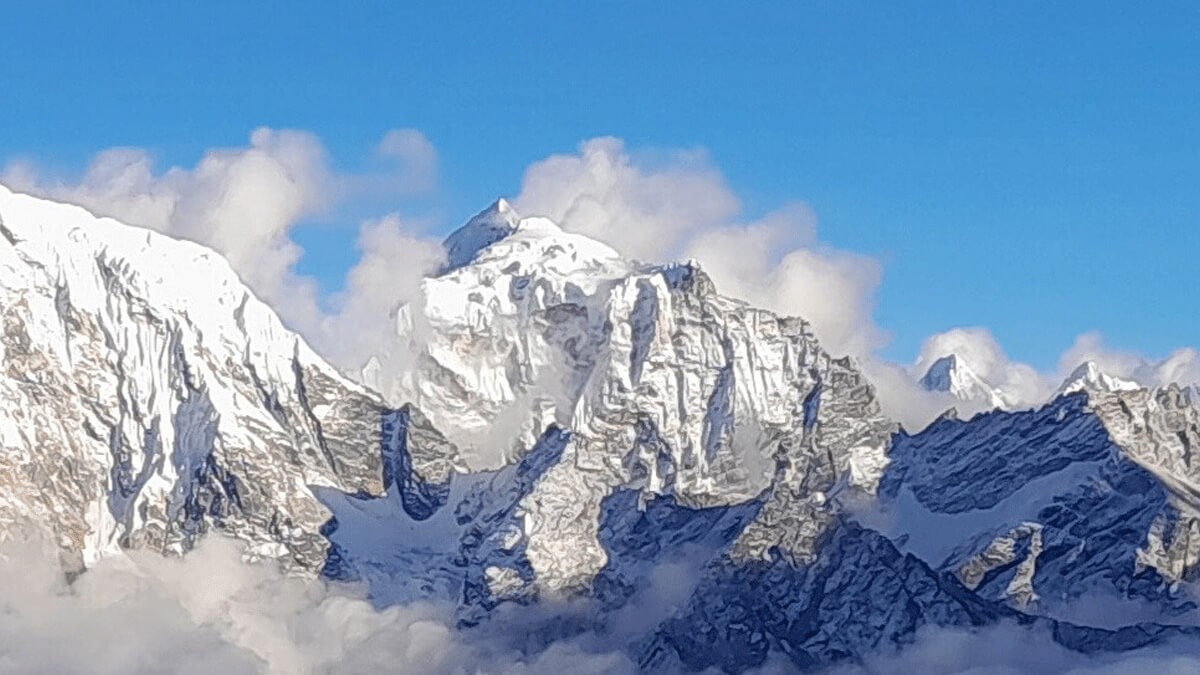
FAQs
When is the best time to trek in the Kanchenjunga region?
Spring (March to April) and Autumn (September to November) are the optimal periods of the year for Kanchenjunga trekking due to their stable weather and moderate temperature. During these times, dry trails allow you to navigate difficult sections of the region, reducing avalanches and landslides since the chance of rainfall and snowfall is minimal.
Nature lovers and mountain enthusiasts can take full advantage of the suitable climate that offers the most breathtaking vistas of towering snow-clad mountains, including Mt. Kanchenjunga, Jannu, Kabru, etc., without obstructions. National festivals also occur during these seasons, letting trekkers gain deep insight into the authentic cultures of isolated settlements since locals conduct various festival activities and religious rituals.
What permits do you need to obtain for the Kanchenjunga region?
Before starting your exhilarating journey in the most remote areas of the Kanchenjunga region, you have to take essential permits such as a TIMS Card (Trekkers Information Management System Card), a Kanchenjunga Conservation Area Permit (KCAP), and a Kanchenjunga Restricted Area Permit (KRAP). The Nepal Government has made these permits mandatory to monitor or control overtourism, considering the preservation of the region’s fragile ecosystem.
Why do you need travel insurance for the Kanchenjunga trekking?
Most sections of the Kanchenjunga region are challenging, requiring good physical and mental health. Limited teahouses and health posts are along the trails, making it difficult for trekkers to obtain medical treatment on time while getting injured. Therefore, the right travel insurance is crucial, which also covers helicopter evacuation above 4000m in case of emergency. As the insurance works as a safeguard, covering the expenses for unforeseen circumstances such as flight delay or cancellation, or personal belongings damaged, lost, or stolen, you can enjoy trekking without worrying about extra prices for them.
What type of accommodation and food can you expect on the trails of the Kanchenjunga region?
In lower elevations of the Kanchenjunga, you can get more facilitated lodges and guesthouses, whereas you must adjust to common teahouses with basic services in high mountainous settlements. While talking about food, the common food at teahouses along the way is “Dal and Bhat,” which includes steamed rice, lentil soup, vegetables, and a pickle. Restaurants of large settlements also offer a wide range of western and Tibetan food items, including fried rice, pancakes, etc., thukpa, momo, butter tea, tsampa, etc.
Are a guide and a porter compulsory to hire?
According to the Nepal Government rules, a professional guide is mandatory for a trekking permit, whereas a porter is not compulsory. However, you can hire both to make your Kanchenjunga trekking more enjoyable, as they both will be your right hand throughout the journey. Guides help you in navigating demanding terrains, and porters carry your heavy loads of crucial trekking equipment to let you dive into the wilderness of the Kanchenjunga region.
